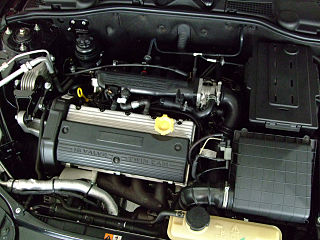H.263 is a video compression standard originally designed as a low-bit-rate compressed format for videotelephony. It was standardized by the ITU-T Video Coding Experts Group (VCEG) in a project ending in 1995/1996. It is a member of the H.26x family of video coding standards in the domain of the ITU-T.

A video codec is software or hardware that compresses and decompresses digital video. In the context of video compression, codec is a portmanteau of encoder and decoder, while a device that only compresses is typically called an encoder, and one that only decompresses is a decoder.
DOD, Dod and DoD may refer to:

The Rover K-series engine is a series of internal combustion engines built by Powertrain Ltd, a sister company of MG Rover. The engine was a straight-four cylinder built in two forms, SOHC and DOHC, ranging from 1.1 to 1.8 L; 67.9 to 109.6 cu in.

Variable valve timing (VVT) is the process of altering the timing of a valve lift event in an internal combustion engine, and is often used to improve performance, fuel economy or emissions. It is increasingly being used in combination with variable valve lift systems. There are many ways in which this can be achieved, ranging from mechanical devices to electro-hydraulic and camless systems. Increasingly strict emissions regulations are causing many automotive manufacturers to use VVT systems.

The VK engine is a V8 piston engine from Nissan. It is an aluminum DOHC 4-valve design.

Ateme S.A. is a multinational company that specializes in video compression, CDN/streaming, cloud recording and advertising. It develops software for video compression based on the main standards: MPEG2, H.264/AVC, H.265/HEVC, AV1 and H.266/VVC. Ateme solutions also feature packaging capabilities with MPEG2-TS, HLS and DASH output. These solutions are used by content providers, broadcasters, multichannel video programming distributors, and streaming providers for delivery over cable, satellite, IPTV, terrestrial, and OTT networks.

The Valvetronic system is a BMW variable valve lift system which, in combination with VANOS, allows infinite adjustment of the intake valve timing and lift. The system claims to improve fuel economy and emissions, and negates the need for a throttle body in regular use.

The Rover 200 Coupé is a two-door coupé that was produced by Rover and based on the Rover 200 Mark II, with most of the body panels and the bumpers unique in the range. The car was launched on 6 October 1992, at the Paris Motor Show. It was given the project code name 'Tomcat' when in development.
The Video Coding Experts Group or Visual Coding Experts Group is a working group of the ITU Telecommunication Standardization Sector (ITU-T) concerned with standards for compression coding of video, images, audio signals, biomedical waveforms, and other signals. It is responsible for standardization of the "H.26x" line of video coding standards, the "T.8xx" line of image coding standards, and related technologies.
VVC is an automobile variable valve timing technology developed by Rover and applied to some high performance variants of the company's K Series 1800cc engine.

MultiAir or Multiair is a hydraulically-actuated variable valve timing (VVT) and variable valve lift (VVL) engine technology enabling "cylinder by cylinder, stroke by stroke" control of intake air directly via a gasoline engine's inlet valves. Developed by Fiat Powertrain Technologies, the technology addresses a primary engine inefficiency: pumping losses caused by restricting intake passage by the throttle plate that regulates air feeding the cylinders.
The YCoCg color model, also known as the YCgCo color model, is the color space formed from a simple transformation of an associated RGB color space into a luma value and two chroma values called chrominance green (Cg) and chrominance orange (Co). It is supported in video and image compression designs such as H.264/MPEG-4 AVC, HEVC, VVC, JPEG XR, and Dirac. It is simple to compute, has good transform coding gain, and can be losslessly converted to and from RGB with fewer bits than are needed with other color models. A reversible scaled version with even lower bit depth, YCoCg-R, is also supported in most of these designs and is also used in Display Stream Compression. The more complete definition with variable bit depths of Y and chrominance values is given in ITU-T H.273.
Versatile Video Coding (VVC), also known as H.266, ISO/IEC 23090-3, and MPEG-I Part 3, is a video compression standard finalized on 6 July 2020, by the Joint Video Experts Team (JVET) of the VCEG working group of ITU-T Study Group 16 and the MPEG working group of ISO/IEC JTC 1/SC 29. It is the successor to High Efficiency Video Coding. It was developed with two primary goals – improved compression performance and support for a very broad range of applications.

Low Complexity Enhancement Video Coding (LCEVC) is a ISO/IEC video coding standard developed by the Moving Picture Experts Group (MPEG) under the project name MPEG-5 Part 2 LCEVC.
This page is based on this
Wikipedia article Text is available under the
CC BY-SA 4.0 license; additional terms may apply.
Images, videos and audio are available under their respective licenses.








